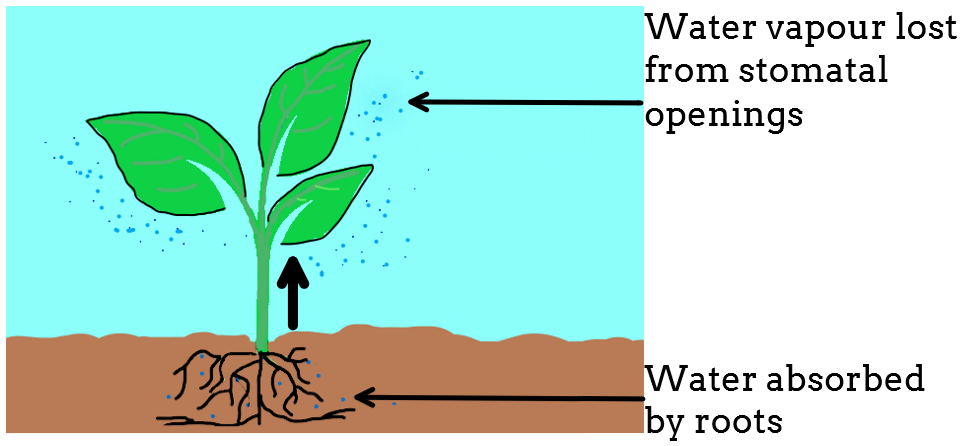
Demonstrate the phenomenon of transpiration
Answer
580.5k+ views
Hint: Transpiration is a phenomenon that helps in passive absorption of water. It is absent from desert plants or plants living in xerophytic conditions. Transpiration influences climatic factors such as precipitation over a region.
Complete answer:
Transpiration is the process by which water is lost in the form of water vapor from the leaf surfaces through the stomatal opening. Loss of water generated a pull throughout the xylem vessel which helps in water absorption. Transpiration rate is measured by a device known as the potometer.
Transpiration is mainly of three different types:
-Cuticular transpiration: Transpiration occurs through the cuticle. It contributes 3-10% to the total transpiration is trees, but in herbs and ferns, cuticular transpiration accounts for almost 50% of the total transpiration.
-Stomatal transpiration: Stomatal transpiration is how maximum water loss takes place. It accounts for 50-97% of total transpiration. It occurs only through leaves.
-Lenticular Transpiration: Lenticels present on the woody stems may also take part in transpiration. They contribute a very small percentage to transpiration which is around 0.1 to 1%.
-Transpiration helps in the cooling of plants when temperatures are too high.
-The rate of transpiration is dependent on several factors like humidity, wind speed, temperature, etc.
-Transpiration is absent in plants surviving under xerophytic conditions. Leaves of these plants are converted into spines to prevent water loss by transpiration.
Note: It should be remembered that even though leaves are reduced to spines in xerophytes, still transpiration is observed in these xerophytes. These tend to open their stomata only at night time so that too much water is not lost by excessive evaporation during day time. Several adaptations are shown by xerophytic plants, such as low stomatal density, thick cuticle, reduction of leaves to spine, etc.

Complete answer:
Transpiration is the process by which water is lost in the form of water vapor from the leaf surfaces through the stomatal opening. Loss of water generated a pull throughout the xylem vessel which helps in water absorption. Transpiration rate is measured by a device known as the potometer.
Transpiration is mainly of three different types:
-Cuticular transpiration: Transpiration occurs through the cuticle. It contributes 3-10% to the total transpiration is trees, but in herbs and ferns, cuticular transpiration accounts for almost 50% of the total transpiration.
-Stomatal transpiration: Stomatal transpiration is how maximum water loss takes place. It accounts for 50-97% of total transpiration. It occurs only through leaves.
-Lenticular Transpiration: Lenticels present on the woody stems may also take part in transpiration. They contribute a very small percentage to transpiration which is around 0.1 to 1%.
-Transpiration helps in the cooling of plants when temperatures are too high.
-The rate of transpiration is dependent on several factors like humidity, wind speed, temperature, etc.
-Transpiration is absent in plants surviving under xerophytic conditions. Leaves of these plants are converted into spines to prevent water loss by transpiration.
Note: It should be remembered that even though leaves are reduced to spines in xerophytes, still transpiration is observed in these xerophytes. These tend to open their stomata only at night time so that too much water is not lost by excessive evaporation during day time. Several adaptations are shown by xerophytic plants, such as low stomatal density, thick cuticle, reduction of leaves to spine, etc.

Recently Updated Pages
The number of solutions in x in 02pi for which sqrt class 12 maths CBSE

Write any two methods of preparation of phenol Give class 12 chemistry CBSE

Differentiate between action potential and resting class 12 biology CBSE

Two plane mirrors arranged at right angles to each class 12 physics CBSE

Which of the following molecules is are chiral A I class 12 chemistry CBSE

Name different types of neurons and give one function class 12 biology CBSE

Trending doubts
One Metric ton is equal to kg A 10000 B 1000 C 100 class 11 physics CBSE

What is 1s 2s 2p 3s 3p class 11 chemistry CBSE

Discuss the various forms of bacteria class 11 biology CBSE

State the laws of reflection of light

Explain zero factorial class 11 maths CBSE

An example of chemosynthetic bacteria is A E coli B class 11 biology CBSE




